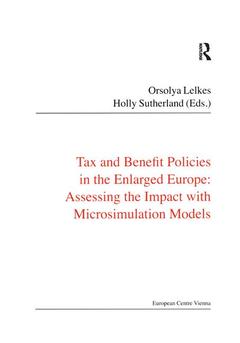Description
Tax and Benefit Policies in the Enlarged Europe
Assessing the Impact with Microsimulation Models
Public Policy and Social Welfare Series
Author: Sutherland Holly
Coordinator: Lelkes Orsolya
Language: English
Subject for Tax and Benefit Policies in the Enlarged Europe:
Keywords
Tax Benefit Systems; models; MSM; systems; Cue; poverty; UK System; rate; Household Disposable Income; flat; Labour Market Participation Decisions; household; Labour Market Participation; disposable; Effective Marginal Tax Rates; income; Tax Allowances; microsimulation; Flat Tax; child; Social Assistance Benefits; Anthony B; Atkinson; Equivalized Household Disposable Income; Alari Paulus; Social Insurance Contributions; Mitja Čok; Gdp Growth; Francesco Figari; Tax Benefit Policy; Péter Hegedűs; Percentage Points; Silja Kralik; Tax Free Income; Nataša Kump; Child Tax Credit; Horacio Levy; PL-2007 System; Christine Lietz; Large Families; Daniela Mantovani; In-work Benefits; Leszek Morawski; Young Man; Péter Szivs; Lone Parent; Andres Võrk; Flat1 Scenario; Michal Myck; Market Income; Lina Salanauskaite; Gerlinde Verbist; Panos Pashardes; Alexandros Polycarpou; Herwig Immervoll
Publication date: 01-2018
· 17.4x24.6 cm · Hardback
Publication date: 06-2009
224 p. · 17x24 cm · Paperback
Description
/li>Contents
/li>Biography
/li>
These books may interest you

Farm-Level Microsimulation Modelling 121.31 €

Farm-Level Microsimulation Modelling 121.31 €


